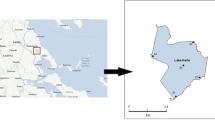Summary
Numerical calculations were made to determine the steady state features of the wind-driven circulations in Lake Ontario. It is assumed that the water in the lake may be represented by an incompressible homogeneous fluid layer, a condition that is typical of a winter situation. The linearized mass transport equations are then solved for an imposed wind stress on the surface of the lake. Effects of bottom friction, bottom topography, lateral boundary configuration are taken into account Effect of rotation is represented by a constant Coriolis parameter. Circulation patterns were calculated for the cases of uniform and spacially variable wind stress. It was shown that bottom topography strongly influences the circulation features. The dominant feature of the circulation is a two-cell pattern with a small counter-clockwise circulation cell in the southern part of the lake and a large clockwise cell in the northern part with an intense west-ward return flow in the interior of the lake.
Zusammenfassung
Der stationäre Anteil der windgetriebenen Zirkulation im Ontariosee wurde numerisch berechnet. Es wurde dabei angenommen, daß die Wassermassen im See durch eine inkompressible homogene Flüssigkeitsschicht angenähert werden können, ein Zustand, der für Winterverhältnisse typisch ist. Die linearisierten Massentransportgleichungen wurden für eine auf die Seeoberfläche wirkende Windschubspannung gelöst. Die Einflüsse von Reibung am Seeboden, Gestalt des Seebodens und Gestalt der seitlichen Begrenzung des Sees wurden in Rechnung gestellt. Der Effekt der Erdrotation wurde durch einen konstanten Coriolisparameter berücksichtigt. Strömungsverhältnisse wurden für die Fälle gleichförmiger und örtlich veränderlicher Windschubspannungen berechnet. Es wurde gezeigt, daß die Gestalt des Seebodens die Strömungsverhältnisse stark beeinflußt. Die Strömungsanordnung wird vorherrschend durch zwei Zirkulationszellen charakterisiert: Geringfügige Bewegung im Gegenuhrzeigersinn im südlichen Teil des Sees sowie eine stark ausgeprägte Bewegung im Uhrzeigersinn im nördlichen Teil des Sees. Eine intensive, westwärts gerichtete Gegenströmung herrscht in der Mitte des Sees vor.
Similar content being viewed by others
References
Ayers, J. C.: A Dynamic Height Method for the Determination of Currents in Deep Lakes. Limnology and Oceanography, Vol. 1, pp. 150–161 (1956).
Birchfield, G. E.: Horizontal Transport in a Rotating Basin of Parabolic Depth Profile. J. Geophys. Research72, 6155–6164 (1967).
Csanady, G. T.: Wind-driven Summer Circulation in the Great Lakes. J. Geophys. Res.73, 2579–2589 (1968).
Fox, L.: Numerical Solution of Ordinary and Partial Differential Equations. Pergamon Press, 509 pp. (1962).
Harrington, 1895 (quoted byHutchinson, G. E.: A Treatise on Limnology, Vol. 1, New York: John Wiley and Sons, Inc., 1957).
Scott, J. T., andL. Livingston: Gradient Circulation on Eastern Lake Ontario. Proceedings, Tenth Conference on Great Lakes Research, pp. 322–336 (1967).
Thompson, P. D.: Numerical Weather Analysis and Prediction. New York: The Macmillan Company, 1961.
Author information
Authors and Affiliations
Additional information
With 11 Figures
Rights and permissions
About this article
Cite this article
Rao, D.B., Murty, T.S. Calculation of the steady state wind-driven circulations in Lake Ontario. Arch. Met. Geoph. Biokl. A. 19, 195–210 (1970). https://doi.org/10.1007/BF02249005
Received:
Issue Date:
DOI: https://doi.org/10.1007/BF02249005




